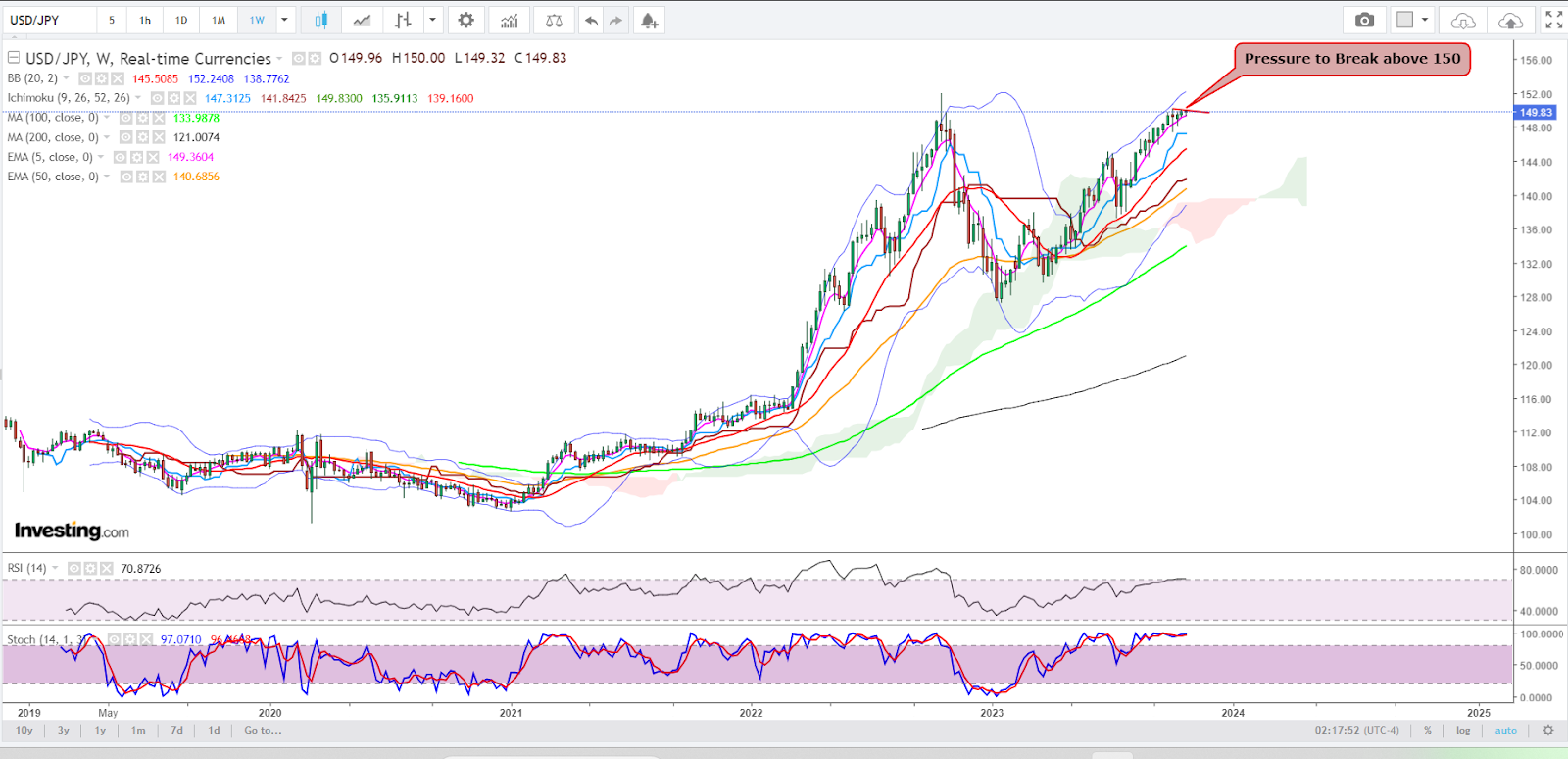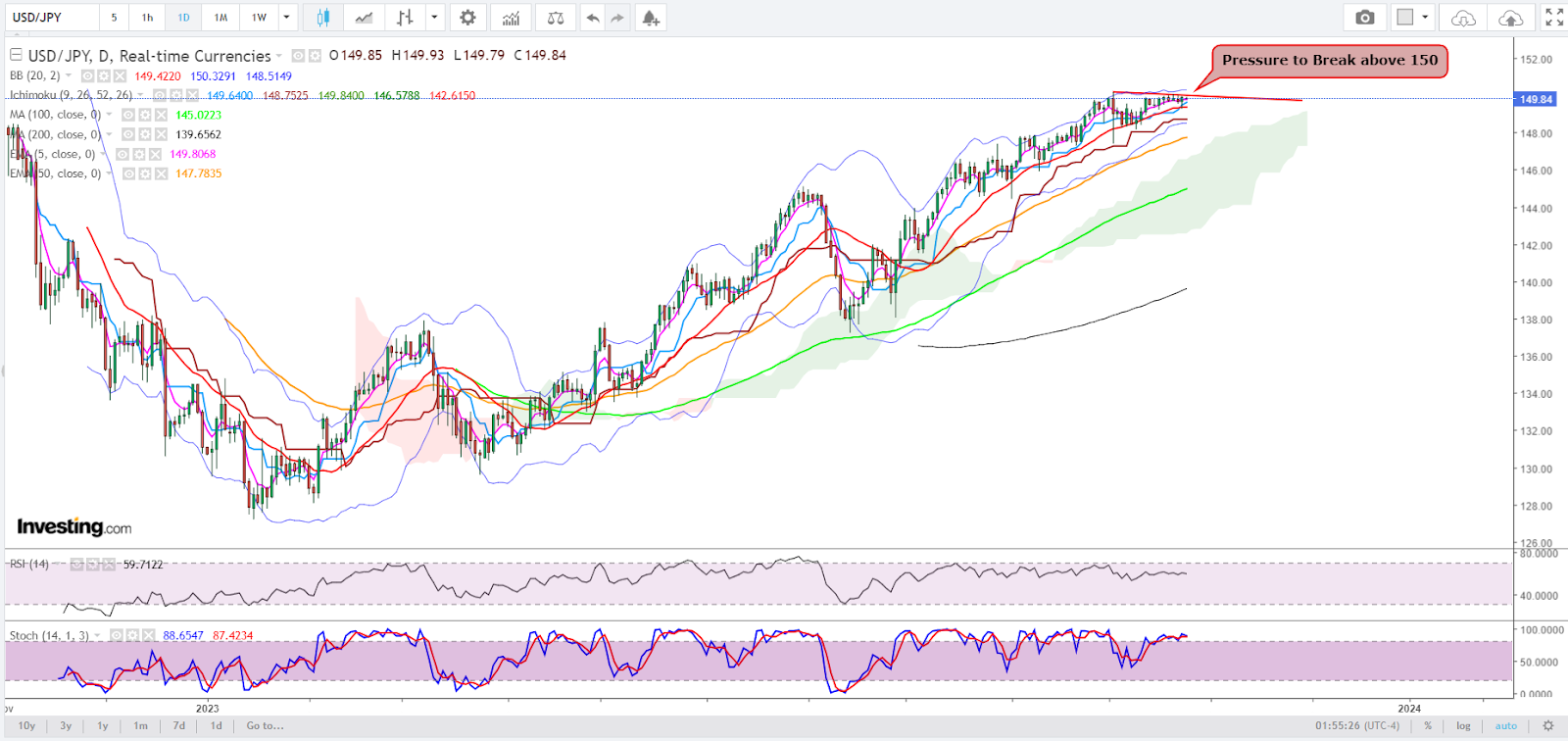- After sensational yen support of 150, Tokyo has sat back, allowing suspense to build
- Dollar, meanwhile, not collapsing, as US exceptionalism drives greenback’s strength
- Investing.com charts study suggest USD/JPY could run to between 151.96 and 153
- Intervention could be within that upper bullish channel
Thrice in a week, the Japanese government passed on intervening in the forex markets when the USD/JPY pair crossed 150 to the dollar.
Why 150?
It wasn’t so much a magic number as the level that triggered Tokyo’s monetary authorities to stage a defense of the yen on Oct 3, when it breached that point. As such, expectations were set around there for Japanese monetary authorities to act and they didn’t.
The greenback has, however, been relentless — not collapsing as many projected it to but instead springing back at every attempt to push below 105 the Dollar Index that ties the currency against six majors, including the yen.
Surprisingly good US macroeconomic data that keeps reinforcing the story of American exceptionalism versus the rest of the world has been a driver for the dollar.
That doesn’t look like it's going to end anytime soon with third-quarter US gross domestic product, or GDP, growth projected at 5.4% by the Atlanta Fed, a division of the central bank.
The Federal Reserve itself may be done with rate hikes after 11 increases between March 2022 and July 2023 that brought the key US lending rate to 5.25% from a previous 0.25%. But the dollar isn’t done going up.
The sell-off in US bonds cannot stop beyond a few days either, keeping the yield on the benchmark US 10-year Treasury note not too far from Monday’s 16-year high of 5.021%.
Time… and Every Imaginable Odd Stacked Against the Yen
Charts by SKCharting.com, with data powered by Investing.com
The dollar’s strength brings us to what’s in store for the yen. Japan's flash Purchasing Managers Index, or PMI, points to a stalling private sector economy at the start of the fourth quarter, raising early recession warning signals for the Bank of Japan, or BOJ.
The Services PMI fell from 53.8 to 51.1, expanding at the weakest pace in 2023. Significantly, the services sector accounts for over 70% of the Japanese economy and the labor market.
With the yen though, the odds are stacked against it at every turn. Firstly, the chance of the BOJ doing a policy U-turn before the end of the year is highly remote.
The odds don’t get better even over the longer time horizon. The yield on the Japan 10-Year note has barely budged above 0.76%.
The BOJ’s real problem, as multiple analyses suggest, is time — or rather, the lack of it.
Right now, Japan’s central bank can’t abandon its ultra-easy monetary policy settings because the ‘virtuous cycle’ between wage growth and inflation is not yet self-sustaining.
While Japan is battling inflation, it’s also fighting sluggish economic growth, challenging demographics, and a deflationary mindset among its people that make a sustainable pickup in wages next year anything but certain.
Until that becomes a plausible scenario in itself, the BOJ is unlikely to significantly alter yield curve control – the policy of suppressing bond yields lower than where market forces would normally dictate – nor lift its key overnight policy rate from -0.1%.
So, we may go into late 2024 — or well beyond that, provided it even gets there — for the BOJ to unwind its super-easy settings.
But the ever-present threat of support intervention for the yen leaves the USD/JPY short of 150.
With three “opportunities” passed up by the government to do the needful over the past week, the burning question in forex markets is what will prod the Bank of Japan to act.
Japan spent around 9 trillion yen (or around $60 billion) in September and October last year across three occasions in their first intervention to support the yen since 1998.
This year the currency has weakened more than 12% against the dollar, making it the worst performer among its Group-of-10 peers.
Japan’s chief currency official Masato Kanda has said that as a general principle, rate hikes and interventions are ways to respond to excessive currency moves.
He has vowed to take action if needed against excessive swings, but declined to say whether recent market moves were speculative.
Still, the International Monetary Fund has said that it sees no factors that would compel Japan to intervene in the foreign exchange market to support the yen.
What Could Be the Trigger Point for the Next Yen Intervention?
Japanese officials have ostensibly set a higher watermark for the defense of the yen, leading to raging speculation across the forex market on what that could be.
Drawing on the logic of how far the dollar’s “bullets” could go against the yen — without being presumptuous about the tolerance levels of the government— a joint study of yen charts by Investing.com and SKCharting.com suggests that bulls were targeting an interim to mid-term target of 152 to 153.
Said SKCharting’s chief technical strategist Sunil Kumar Dixit, a long-term collaborator with Investing.com, explains the rationale:
“I’d imagine that if any intervention level is being contemplated, it has to take account the highs the bulls have in sight, in order to effectively short circuit that. Our chart runs suggest a near to medium term range for USD-JPY that would began at 151.96 and run to 153. Thus, that could also be the range that the Japanese government is keeping open to fight the dollar.”
The last time USD-JPY breached 153 was in July 1987, making for a 36-plus year high if the level is revisited before next July.
On the outlook for USJ-JPY itself, price action continues to coil on the strong side above the Daily Middle Bollinger Band of 149.42, as well as the 5-day EMA, or Exponential Moving Average, of 149.80, said Dixit. He adds:
“As such, the pressure seems to be on rise for a breakout above the 150 psychological handle.
The current bullish momentum remains intact as long as price action maintains stability above horizontal support 148.75.”
A double top may form from the 151.96 resistance, ahead of the exhaustion in store of the intended 153 peak.
“A break below 148.75 followed by a consistent Day/Week close below the zone may signal weakness in price and beginning of downward correctional wave.”
***
Disclaimer: The aim of this article is purely to inform and does not in any way represent an inducement or recommendation to buy or sell any commodity or its related securities. The author Barani Krishnan does not hold a position in the commodities and securities he writes about. He typically uses a range of views outside his own to bring diversity to his analysis of any market. For neutrality, he sometimes presents contrarian views and market variables.



